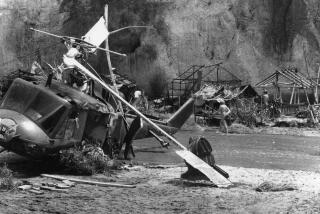Why Director Adrian Lyne Went for the Jugular
- Share via
Remember the controversial finale of “Fatal Attraction,” a bloody bathroom scene during which Anne Archer guns down Glenn Close shortly after Michael Douglas dunks her in a bathtub? Some movie fans may recall that another, far less violent ending was first shot by director Adrian Lyne.
The original conclusion to the 1987 thriller will be included on a new home-video and laser-disc release of “Fatal Attraction” in March from Paramount Home Video as part of its “Directors’ Series.”
As the story went in Hollywood at the time, Lyne’s initial ending was panned at test screenings, prompting Paramount Pictures marketing executives to demand a more audience-friendly resolution. So Lyne brought back the principal cast six months after the film wrapped to re-shoot a climax aimed at the jugular. “Fatal Attraction” went on to scare up box-office receipts in excess of $156 million.
Lyne, for his part, is tired of hearing that story.
“People have suggested in the press that there were rows of marketing people thinking they could squeeze another few million dollars out of the movie if they changed the ending,” the director said last week. “It just doesn’t happen that way by my experience. It’s nonsense, this idea of marketing people sitting there deciding how the film is going to end. It’s silly.”
The decision to swap endings was his, Lyne insists, and he stands by his decision today.
Lyne was widely criticized at the time for ditching the first ending he shot and replacing it with one more typically associated with a cut-rate slasher movie.
Newsweek’s David Ansen wrote of the switch: “A smattering of psychological veracity gets cynically chucked out the window for the sake of cheap thrills.” Negative press grew worse when the original ending played to receptive theater audiences in Japan, because Japanese distributors liked it better.
In the original 12-minute ending of “Fatal Attraction,” Douglas is handcuffed and dragged away from his family for the murder of Close, whose body police discover in her apartment beside a knife with Douglas’ fingerprints. Only an audio cassette discovered by Archer, on which Close threatens suicide, saves her husband from prison. In the last eerie scene, Close, sitting cross-legged in the bathroom with “Madama Butterfly” wafting in the background, reprises the opera’s climax and slowly draws a knife across her throat.
Lyne said that that cut of “Fatal Attraction” was screened three times--in Los Angeles, San Francisco and Seattle. During one of the screenings, Lyne, producer Stanley Jaffe and writer James Dearden sat in the back row of the theater.
When it came to the ending, “I could feel the film go flat,” Lyne recalled. “And the audience was so with the movie until that point, that it felt dramatically unsatisfying at the end. So we decided to make a change, only and purely for dramatic reasons.”
It wasn’t the first change, either. In Dearden’s initial screenplay, Close successfully frames Douglas and he’s imprisoned for murder. Lyne found that denouement too dark because all three characters lost, so he contrived the cassette tape as a way to free Douglas. But the response of preview audiences to the film changed the director’s mind once again.
“I thought Anne Archer finding the cassette tape was facile and easy and too convenient,” he said. “However, I also felt the original ending, which I read in the screenplay, was unsatisfying. Because if you spend two hours trying to get an audience involved in a family, and you succeed, then to abandon them isn’t really fair.”
Lyne, now casting a film called “Indecent Exposure” to begin shooting in March, said that the notion of a former TV commercial director abandoning his artistic integrity for box-office bucks made good press. In regard to “Fatal Attraction,” Lyne suggested that he and journalists are not so different, each searching for the best drama.
“It made a good story, the idea of Hollywood being this venal place that had made this filmmaker sell out in the last 10 minutes of his movie,” Lyne said. “As I’ve explained, that was totally untrue. But once that’s planted, everybody kind of stands in line to print it. That’s very hard to dispel.”
More to Read
Only good movies
Get the Indie Focus newsletter, Mark Olsen's weekly guide to the world of cinema.
You may occasionally receive promotional content from the Los Angeles Times.









